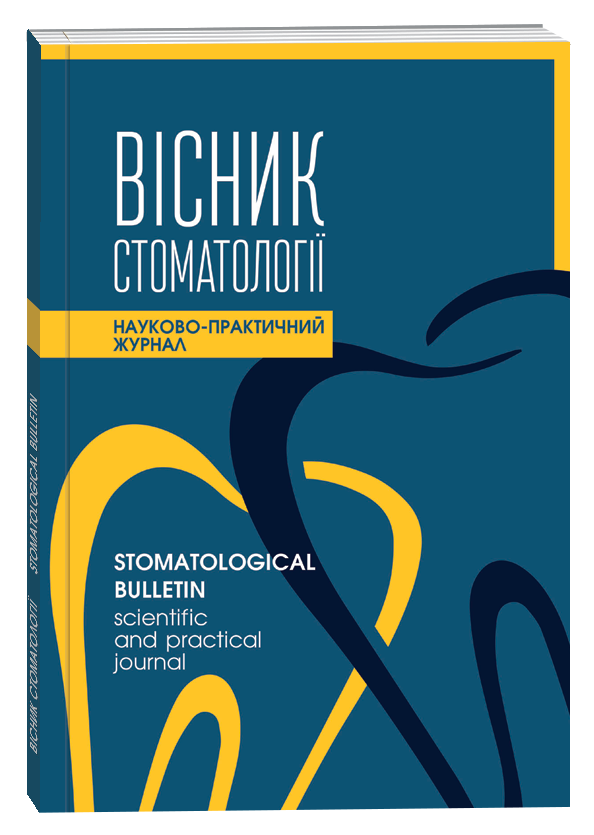MECHANICAL AND MATHEMATICAL MODELING OF THE PROCESS OF TREATMENT OF DENTITION DEFECTS OF THE FRONTAL AREA IN CHILDREN AND ADOLESCENTS
DOI:
https://doi.org/10.35220/2078-8916-2021-39-1-15-19Keywords:
defects in the dentition rows, the place of ap-plication of force, the direction of action of orthodontic forceAbstract
Topicality of research. Treatment of dentition defects of the frontal area in children and adolescents involves the usage of special devices, that is prosthesis appliances, that have specific design features. Such devices create or-thodontic forces. As the force is a vector characteristic, it means that it is necessary to determine the magnitude, di-rection and the point of the force application to provide treatment. The purpose of research. Was improvement of the meth-ods of treatment of dentition defects, in particular, the frontal area in children and adolescents based on the process of mechanical and mathematical modeling using a non-removable orthodontic prosthesis appliance on the upper jaw. Materials and methods. The subject of the research was a system consisting of a dento-maxillaire complex of a pa-tient and an orthodontic device for treatment of dentition defects of the frontal area in children and adolescents on the upper jaw during orthodontic treatment. The research was carried out by the method of theoretical mechanics and mechanics of a deformable solid. Results. The point of application and direction of the or-thodontic force significantly influences teeth movement. According to the way the orthodontic force is applied, it can produce a translation movement of a tooth or transla-tion-rotational one. The type of teeth movement depends on the relative posi-tion of the orthodontic force vector and the resistance forces that are applied from the jaws’ bone tissue. Re-sistance forces are applied to the tooth root surface and their action can be replaced by an equal force that passes through the center of the resistance of the tooth. The cen-ter of the resistance is the point through which the result-ant pasese that prevents teeth from movement. The center of tooth resistance is in the middle part of the tooth root.
Here is the case when the orthodontic force vector is ap-plied in the direction parallel to the occlusal plane and passes through the center of the resistance of the tooth root. The action of orthodontic force causes the appear-ance of normal stresses, which are evenly distributed at the point that passes through the axis of the tooth. Since the vectors of the resultant resistance force and orthodon-tic force coincide in the direction, the tooth moves translationally and parallel to the occlusal plane in the direction of the orthodontic force.
When the orthodontic force vector passes through the center of the resistance of the tooth root at some angle to the occlusal plane, it causes the appearance of not only normal but also tangential stresses. The tooth will move translationally (bodily) in the direction of the orthodontic force.
The case of orthodontic force, the vector of which passes between the apex of the tooth root and the center of the resistance of the tooth causes the appearance of evenly distributed tangential and unevenly distributed normal stresses in the axial section of the tooth. The vectors of the resultant resistance force and the orthodontic force do not coincide in the direction, which leads to translational and rotational movement of the tooth. The tooth in this case rotates clockwise. If the vector of orthodontic force passes between the crown of the tooth and the center of the resistance of the tooth root, the action of the ortho-dontic force will cause the appearance in the axial section of evenly distributed tangential and unevenly distributed normal stresses. But the tangential stresses in this case will act in the opposite direction, restraining the vertical movement of the tooth. The tooth rotates in this case counterclockwise. Conclusions. The point of application and direction of the orthodontic force significantly influencs the teeth move-ment. Depending on how the orthodontic force is applied, the tooth movement can be translational, or translational-rotational.
If the orthodontic force vector is applied in the direction parallel to the occlusal plane and passes through the cen-ter of the resistance of the root, the tooth moves translationally and parallel to the occlusal plane. When the action of orthodontic force, the vector of which passes between the apex of the root and the center of the re-sistance of the tooth, it leads to translational and rota-tional movement of the tooth clockwise. If the orthodontic force vector passes between the crown of the tooth and the center of the resistance of the tooth, in this case, the tooth rotates counterclockwise. If the orthodontic force is not directed through the center of the resistance, the or-thodontic force will cause in addition to the translational movement in the direction of the orthodontic force, also its rotation around the axis of the tooth.
The work is a fragment of a topic of the academic re-search works "Differentiated approach in the choice of treatment of dentition defects of the frontal area in chil-dren and adolescents" (state registration number (0116U008918))
References
Osnach R.H., Tormakhov N.N., Beda A.V. Matematycheskoe obosnovanye prymenenyia ortodontycheskoho metoda zameshchenyia defekta zubnoho riada. Sovremennaia ortodontyia. 2014;2:36-38. [In Russian]
Labii Yu.A., Havaleshko V.P., Rozhko V.I., Kotelban I.S. Protezuvannia defektiv zubnykh riadiv u ditei: problemy, mozhlyvosti ta shliakhy vdoskonalennia (ohliad literatury). Visnyk problem biolohii i medytsyny. 2019; (4): 2 (154): 28-33. [in Ukrainian]
Gabella N. World oral health / N. Gabella // Odontostomatol. Trop. 2012;35(138):3–4.
Kylchevskyi N.A. Teoretycheskaia mekhanyka. — M: Nauka, 1977:480 [In Russian]
Kaskova L.F., Marchenko K.V., Berezhna O.E. Poshyrenist zuboshchelepnykh anomalii u ditei z urakhuvanniam shkidlyvykh zvychok ta vidnoshennia do ortodontychnoho likuvannia. Visnyk ukrainskoi medychnoi stomatolohichnoi akademii. 2015; (15):1 (49):17-20. [in Ukrain-ian]









